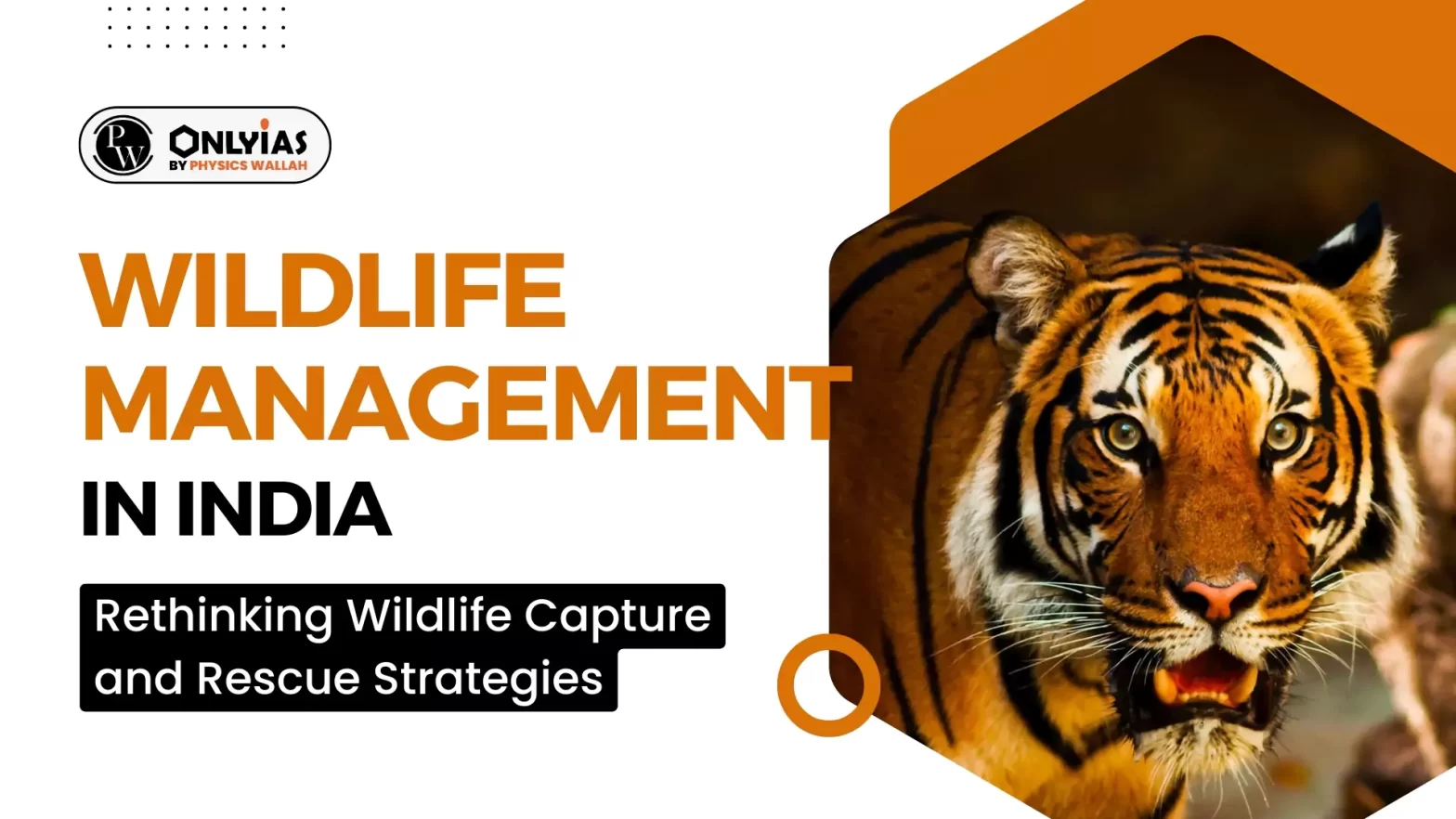Context
In India, the frequency of human-wildlife interactions is on the rise. Addressing conflicts with wildlife requires solutions beyond reactive capture and relocation.
Enroll now for UPSC Online Course
Wildlife Management in India – Wildlife Capture and Rescue
- Rescue: It refers to the act of assisting wild animals in distress, such as those who have been hurt, orphaned, or are stuck in a perilous position.
- Capture: Capture is the act of taking wild animals into custody, which is commonly done in response to confrontations with humans, such as when an animal threatens human safety or property. This could include catching, sedating, or physically restricting the animal.
Case Studies Related to the Wildlife Management in India
- Elephant Incident in South India: An elephant, ostensibly rescued from a coffee plantation, faced tragic consequences post-release.
- Leopard Encounter in Balrampur (UP): A leopard ‘rescued’ from an agricultural field died within hours, highlighting the fallacy of labeling every capture as a rescue.
What Are the Problems of Wildlife Management in India?
- Unsustainability of Reactive Methods: Methods like capture and relocation are often unsustainable or harmful to animals. Distinguishing between wildlife rescue and capture presents a nuanced challenge.
- Complexities of Successful Capture: Successful capture involves various techniques like chemical and physical immobilization. Expert teams with specific roles are essential for safely capturing animals.
- Examples of Rescue Situations: Rescue situations include animals such as leopards, elephants, and snakes trapped in precarious situations like wells, tanks, or homes.
- Rescue Beyond Necessity: Encounters with wildlife outside their usual habitats may not demand immediate rescue. Instances like minor disruptions such as livestock predation or crop damage might not necessitate capture.
- Efficient Conflict Resolution: Effective conflict management doesn’t always resort to capture or relocation. Proactive approaches aim to diffuse tense situations while safeguarding animal welfare.
- Disregard for Established Guidelines: Official guidelines discourage the capture of animals like leopards or elephants solely based on sightings and advocate preventive measures as the primary approach, reserving capture as a last resort.
- The practice of avoiding capture unless absolutely necessary is often disregarded and recent incidents underscore the repercussions of neglecting this counsel.
Challenges Related to the Snake Management in India
- Misconceptions and Confusion: The distinction between capture, removal, and rescue is often blurred in snake conflict management.
- High Frequency of Interactions: Snakes frequently encounter humans, posing various management challenges.
- Issues with Handling and Removal: Increased interactions lead to inadequate handling during purported ‘rescue’ operations. Unnecessary removal and relocation of snakes exacerbate the situation.
- Survival Struggles After Relocation: Relocated snakes face survival challenges in unfamiliar environments. Relocation fails to resolve conflicts and may even escalate tensions in the vacated area.
- Detrimental Effects on Snakes: ‘Rescue’ operations often inflict physical trauma, injuries, and stress on snakes. These adversities diminish the animals’ chances of survival upon release.
Rethinking the Notion of Wildlife Rescue in India
- Reevaluating Terminology: The term ‘rescue’ implies conflict between species or with human activities. Such framing may demonize certain parties and undermine conservation endeavors.
- Embracing Holistic Community Integration: Instead of fostering division, community management should integrate both human and animal needs. Sustainable conservation necessitates comprehensive approaches that address the welfare of all stakeholders.
Karnataka’s Wildlife Conflict Resolution Framework
- Pragmatic Human Wildlife Conflict Resolution: Conflict resolution with a pragmatic assessment of the situation.
- This entails identifying issues, minimizing stressors for animals, exhausting proactive measures, and basing interventions on ethical considerations.
- Proactive Mitigation Initiatives: Emphasizing proactive measures to preempt conflicts is crucial.
- Examples include deploying early warning systems, conducting regular monitoring, implementing fencing, improving lighting, educating the public, and managing waste.
- Considerations in Relocation: Relocation disrupts ecosystems and has significant animal welfare implications. Effective conflict resolution should consider animal welfare alongside relocation strategies.
- Seeking Win-Win Solutions: Strive for human wildlife conflict resolution approaches that benefit both humans and animals. Focus on leaving everyone better off through thoughtful and ethical interventions.
Enroll now for UPSC Online Classes
Conclusion
Enhanced training, habitat restoration, research, and collaboration are critical for negotiating the hazy lines between wildlife “capture” and “rescue,” assuring compassionate and successful management of human-animal conflict in India.
Also Read: Notification of Rules Framed Under Section 49M of the Wildlife Protection Act 1972
| Prelims PYQ (2022):
With reference to Indian laws about wildlife protection, consider the following statements:
1. Wild animals are the sole property of the government.
2. When a wild animal is declared protected, such animal is entitled for equal protection whether it is found in protected areas or outside.
3. Apprehension of a protected wild animal becoming a danger to human life is sufficient ground for its capture or killing.
Which of the statements given above is/are correct?
(a) 1 and 2
(b) 2 only
(c) 1 and 3
(d) 3 only
Ans: (a) |
![]() 13 Apr 2024
13 Apr 2024

